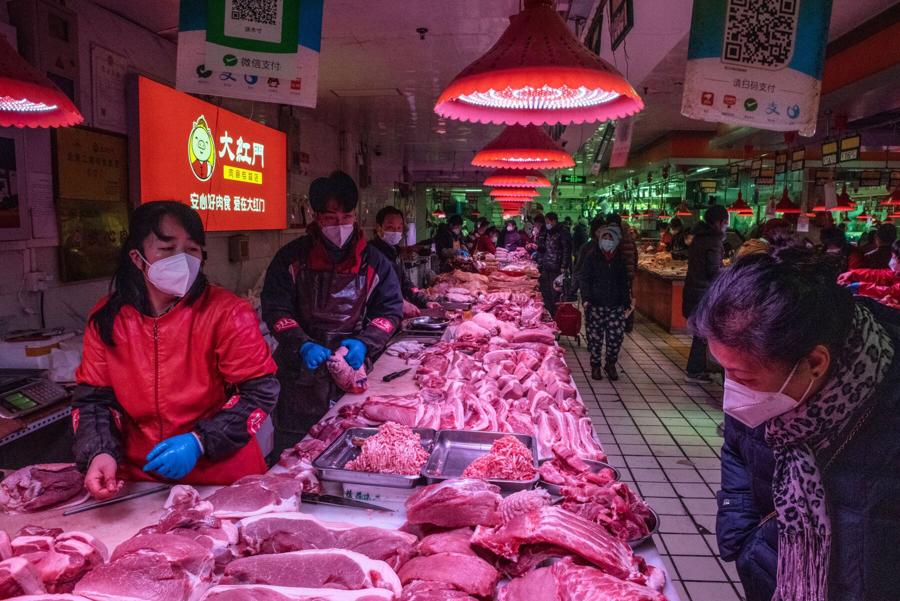Preparing for the Lunar New Year, the most important festival of the year, pork is an essential food for Chinese families. Symbolizing prosperity and abundance, pork is used in countless dishes. However, at the Xinmin market in Beijing, vendor Wu Aizhen is struggling. Despite a 20% decrease in pork prices compared to last year, she is only selling about 70% of the usual amount of meat during the holiday season.
According to Bloomberg, the pork market in China has been sluggish for months due to low demand. However, what is noteworthy is that this trend continues during the peak season, indicating weak pork consumption and excess supply in the world’s second-largest economy. In addition, declining wages have dealt a strong blow, forcing households to tighten their spending.
“It’s very difficult to raise prices this year, even approaching the Lunar New Year,” said Wu, who has been selling pork at Xinmin market for 20 years.
A few hundred kilometers away in the east, butcher Gong Cheng is also worried. He said that in the past, migrant workers – a vital workforce in the construction and textile industries – would spend an average of 1,000 yuan ($140) per household to buy pork and make sausages for the Lunar New Year. However, this year, they only spend 300 yuan or even nothing on this type of food.
“It’s clear that the demand for pork consumption has not increased in line with supply since China reopened after the Covid-19 pandemic last year, even though the number of diners has increased. Despite the bleak data, farmers are still increasing pig herds to compensate for the losses caused by African swine fever,” said Duncan Wrigley, chief China economist at Pantheon Macroeconomics.

China accounts for nearly 50% of global pork consumption and production. Every year, people in China consume more than 5 times the amount of pork compared to the United States. However, last year, the consumption of this food in the country with a population of billions decreased by 1 million tons to nearly 54 million tons, according to data from Shanghai JCI. Although not sudden, this is a significant decline as Chinese families are expected to eat and entertain more after the pandemic, and pork supply has also increased considerably.
This situation adds another gray area to the worrying inflation picture of the world’s second-largest economy. Food accounts for about 20% of China’s Consumer Price Index (CPI), with pork accounting for a significant proportion. In December 2023, China’s CPI fell for the third consecutive month, and this trend is expected to continue into this year.
“The decline in pork consumption is worrisome among low-income consumer groups,” said Darin Friedrichs, co-founder and research director of Sitonia Consulting, a specialized agricultural consultancy in China.
“If you talk about someone working in a bank in Shanghai, they’re fine, they go out and spend money. But in a large proportion of the economy, immigrant workers and manual laborers are not stable at all and they are cutting back significantly,” Friedrichs added.
In a city in Guangdong – a province with a developed economy in China – Li Fumin, manager of more than a dozen self-service restaurants catering to tens of thousands of migrant workers, is worried that he may have to close the restaurants because customers are now opting for cheaper vegetable dishes instead of pork.
“Everyone is struggling to make money, so customers are eating less meat,” Li said. His restaurants have stopped selling expensive items like beef and lamb.
This change in taste, along with changes in eating and entertainment habits, is taking place after years of growth and modernization in China – a period during which the country often faced pork fever and had to take measures to ensure the security of the supply, such as building high-rise pig farms.
Last month’s data showed that China’s pork production in 2023 was the highest in 9 years. Last year, the Chinese government had to intervene 3 times by purchasing pork for strategic reserves to push up prices.
According to Even Pay, an agricultural analyst at Trivium China, the decline in pork consumption creates a “vicious circle” as this increases the supply entering the market.
“For example, livestock companies wait to sell pigs around the Mid-Autumn Festival or in the October holidays, hoping to get higher prices by feeding pigs for longer, but then they sell larger pigs at lower prices,” Pay pointed out.
This situation affects small livestock farming households the most – a group that accounts for about 40% of China’s total pig population.
“This is the first time in my farming career that I have witnessed such large losses,” said Dan Lu, a pig farming expert in southern China. For every 10 small livestock farming households he is in charge of, one has to close down the farm.
Large-scale pig farms are also not immune to the crisis. Fujian Aonong Biological Technology Group, a pig farming facility, announced last week that it may delist from the stock market in the coming years due to consecutive losses caused by low pork prices. Other pig farming companies have either been acquired or sold assets to raise money.





![[Photo Essay]: Experts, Managers, and Businesses Unite to Forge a Path Towards Sustainable Green Industry](https://xe.today/wp-content/uploads/2025/07/z678592918-150x150.jpg)


![[Photo Essay]: Experts, Managers, and Businesses Unite to Forge a Path Towards Sustainable Green Industry](https://xe.today/wp-content/uploads/2025/07/z678592918-100x70.jpg)



